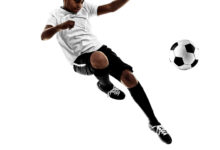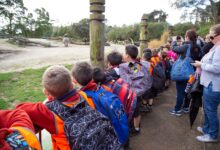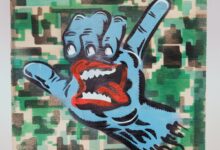Underwater STEAM dream on the world stage
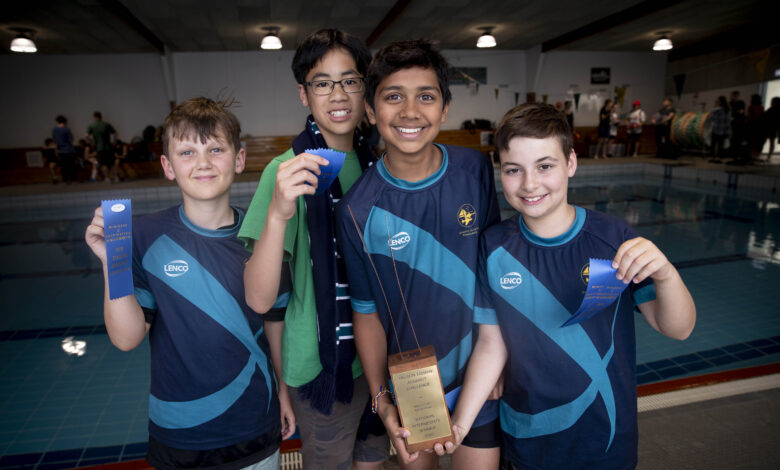
Hobsonville School student Jamie Young was feeling “really confident” after competing in the international aquabots competition – but admits even he was surprised by the result.
“I thought we would get around the top ten,” says the Year 8 student, one of four members of the Aqua Alphas who ended up placing third worldwide in one of the most challenging parts of the American-based competition. “I couldn’t believe it at all!”
Nor could his teammates, Aarav Sharma, Caleb Purcell and Alex Hipperson who all sacrificed countless hours – during and after school and even some of their weekends and school holidays – practising to make sure they were well prepared for the International SeaPerch competition, which was held online this year due to Covid restrictions.
Rewind four years and none of the boys or their teachers had even heard of aquabots – a Ministry of Inspiration underwater robotics programme where students have to build a bot that they can remotely navigate through obstacles at the bottom of a pool.
Hobsonville Deputy Principal Brad Hill says the school didn’t hesitate when Principal Anne Leitch was contacted by the father of a student at a nearby school in 2018 to see if they were interested in participating in an Auckland challenge.
“We said, ‘that sounds fantastic’. We are always trying to develop technology and digital technology and aquabots fell into that quite perfectly. It all started from there.”
The school teamed up with Whenuapai Airbase where the students received mentoring from the avionics squadron as they designed and built their own bots. That inaugural team (which Aarav, Caleb, Alex and Jamie weren’t part of) did well, winning the 2018 nationals before heading to America for the SeaPerch champs in 2019 held at Maryland University in Washington.
Last year, the boys’ team – the Aqua Alphas – were quick to pick up the mantle at the 2020 nationals in Masterton with Aarav leading them to victory. Now at high school, Aarav says he started aquabots in Year 7 after being selected from about 30 other classmates who had also wanted to be involved.
“I thought it was pretty cool to make a vehicle that could go underwater and then compete using it,” he recalls.
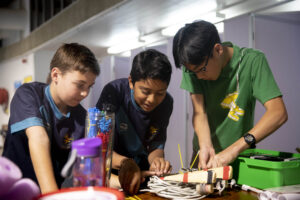
Image: Hobsonville School
Caleb was also selected for a team in 2019 after his teacher put his name forward but admits he knew very little about what aquabots was about. His first year wasn’t the most successful and the team didn’t go any further, then he and Aarav formed a new team with classmates Alex and Jamie that would go on to be a winner.
Armed with just $20 – the maximum amount they were allowed to spend based on the rules of the competition – they bought supplies to modify a prototype Aarav had created and their dream bot was born.
“It was a prototype, then we made it our actual bot and then we started doing tests, like who was our best driver,” says Caleb.
Alex, who was already interested in robotics, jumped at the chance to join the team saying he loved the challenge of designing the bot. “I liked the process of making the aquabot and practising. I didn’t mind about the competition so much, I just liked the process and practice.”
There were hurdles along the way, propellers fell off and motor problems turned out to be an issue with a tether cable. But, the boys persevered and practised at every opportunity they could.
On competition day, the team came face to face with more than 20 other teams from around the country, each having to compete in a series of challenges, including an obstacle course.
The judges unanimously awarded first place overall to the Aqua Alphas, along with a special sportsmanship acknowledgement after they helped another team out. Fellow Kiwi competitors, Team Tahi from Rotorua, also managed to place, coming fourth in the high school division of the international challenge.
“We were all very excited because we knew we’d go to America,” says Caleb. “We were so excited that we jumped into the pool.”
Unfortunately, Covid had other plans and the trip was replaced with a virtual version.
Despite being disappointed, the boys refocused and put all their effort into preparing for global competition. They further developed the design concept of their metal ruler and expanding foam bot, incorporating ideas like hydrofoiling that they had seen during the America’s Cup.
When the competition day came, the boys took out third place. Caleb says the win was a big achievement. “I was very happy because us four kids came third in aquabots in the entire world. Us, in a tiny corner of the world, coming third out of tonnes of university and high school students.”
Deputy Principal Brad Hill, who watched the live judging online, had the privilege of telling the boys about the great result afterwards.
“It was just so cool seeing their faces and watching their reactions to it,” says Hill. “I was immensely proud to see a small group of students from Hobsonville put themselves on a global scale.”
With several of the team now moving to high school, the boys are looking forward to putting some of their new skills into new subjects, like engineering.
And, if Alex has his way, an award-winning aquabot won’t be the last thing he creates – when asked what he wants to be later in life he says something in the field of science and engineering might be on the cards: “I’m already thinking about if I was going to make teleportation, how would I do it.”
Encouraging creativity and critical thinking
We all know that rather than teaching Science, Technology, Engineering, Arts and Mathematics as separate subjects, STEAM integrates them into interdependent learning units, based on real-world applications. And the global skills shortage in STEAM-related fields have redefined educational priorities over the past decade.
As well as helping to produce tomorrow’s designers and engineers, STEAM programmes help develop innovative mindsets, critical thinking and problem-solving abilities to ensure that our students become creators, not just consumers, regardless of their chosen field. Providing for a range of STEAM-based teaching and learning will enrich your curriculum and popular current choices include coding and laser cutting, as well as the robotics (of an underwater nature) mentioned above. Adding the arts into the mix transformed STEM into STEAM, in the 2010s.
“Integrating arts activities can decidedly enliven the curriculum content, make lesson outcomes more successful and interesting to both teachers and students, and introduce powerful and inspired creative thinking into the teaching-learning process.”¹
So, what does this mean for your classroom?
Designing your learning spaces to suit your STEAM programmes is key if your students are going to be able to immerse and thrive in a STEAM environment. In order to cater for all the possibilities your STEAM programme holds, classrooms should be created with multi-use in mind. In a teaching world where technology sits alongside technical drawing and science can be a focus next to sketching, having easy access to power points and charging capabilities, as well as easy to clean art stations and a range of equipment will allow for seamless sessions of learning.
International expert in the field of STEAM, Professor Georgette Yakman recommends schools take steps to increase the quality and depth of their STEAM outcomes.
“To help STEAM achieve better results, I recommend: Each school should have a STEAM certified coordinator. As a course specialist, application writer and community liaison, these coordinators should be familiar with the interrelationships of education, science, technology, engineering, art, mathematics, and other disciplines, such as career planning, problem-based learning and curriculum integration.
“Purchasing equipment and design courses should have the vision of sustainable development, both based on the actual situation of STEAM education, but also to meet the future needs of STEAM education. In order to meet the needs of STEAM education, to achieve the deep integration of information technology and STEAM education, teaching methods such as the use of flip-class activities should be used.”²
For those unfamiliar with flip-class, the ‘Flipped Classroom’ is a blended learning model in which traditional ideas about classroom activities and homework are reversed, or “flipped.” In this model, instructors have students interact with new material for homework first. It can provide a blank canvas for students to stimulate creativity and encourage unique innovation, perfectly STEAM-appropriate.
There are many modern myths that stand in the way of schools delivering their STEAM learning potential. A common complaint is how expensive the STEAM equipment can be to purchase.
US-based expert, lead STEAM trainer Mark Herring writes, “In many people’s minds, the way to get STEAM humming in classrooms is to buy the flashiest, shiniest new toys and tools…
“The danger with this approach is that teachers disregard the learning pedagogy that STEAM relies on. The best way to get the most out of STEAM is to have students collaborating and seeking to solve real-world, authentic problems.
“In my experience, the shiny new tech tools can often become a hindrance as the focus becomes the tool and not the process. It’s as silly as builders running around firing their new nail guns into the wood and thinking that they’re actually building.”³
A top tip Herring has learned over the years is the tendency for schools to neglect the ‘E’ in STEAM. He suggests teachers refresh their understanding of what engineering is, taking into consideration the four main forms: chemical, civil, electrical, mechanical.
“All of these disciplines have a body of knowledge that teachers can plan for and enable their students to explore and discover. Having this understanding as a teacher is why professional development and teacher experience is crucial to successful STEAM learning in your school.”
¹ Sousa and Pilecki, From STEM to STEAM: Using Brain-Compatible Strategies to Integrate the Arts, 2013
² Interview with Prof. Georgette Yakman, 2016, by Zhao Hui Chen, Associate Professor, Henan University School of Education Science, Henan Province, the development of information technology research and Lu Xiaoting, Master, Henan University School of Education Science.
³ 5 Myths about STEAM Learning, Mark Herring, Dec 2017







